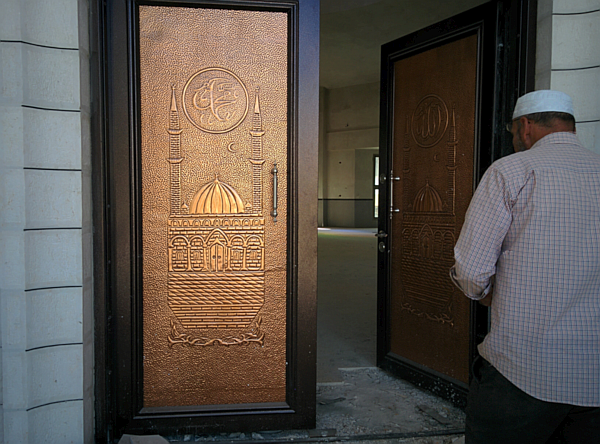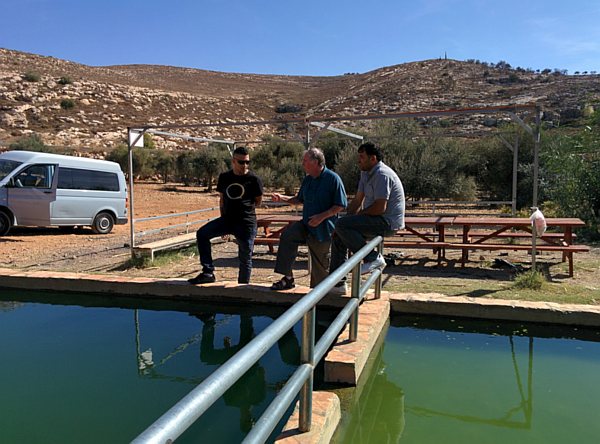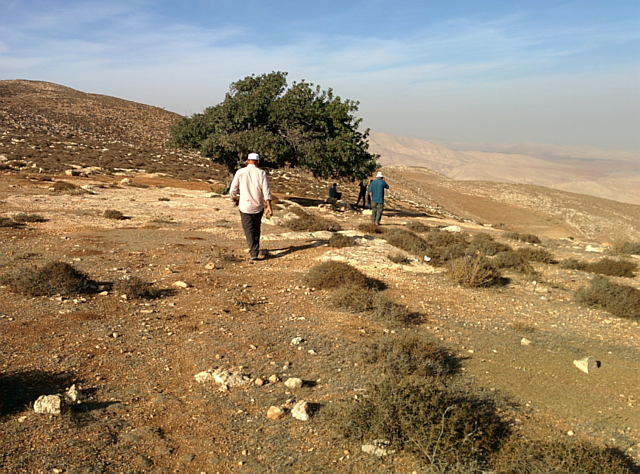Our purpose was to learn about two maqams located on the Jabal al-Kbira ridge, east of Nablus, and determine whether Palestinians can access them. We planned to visit the sites accompanied by the Palestinians and film interviews with them.
Information from the Mapa website: “Jabal Kbir rises between the valley of Nablus to the southwest and the Tirza watercourse to the northwest. The ridge is 7 kilometers long, from Sheikh Bilal in the northwest to Sheikh Kamel in the southwest.”
- The Sheikh Bilal ibn Rabah maqam, named for Islam’s first muezzin, is imprisoned within the Mount Kabir Nature Reserve, which can be accessed only with an entry permit to the Alon Moreh settlement. There is no alternate or separate road to the maqam and the settlement. Prior to 1983, dirt roads connected it to villages in the area - Dayr al-Hatab, Azmut and Salam, and to Nablus.
- The Sheikh Kamel maqam to the south of the ridge, near Beit Dajan, is located in an open area that the army appears to be using for training purposes. It is in very poor condition, and almost in ruins. The three persons who have accompanied us from Dayr al-Hatab say the army destroyed it and prevented them from rebuilding it. Along the way, from our observation point, they pointed out, with concern, the new prefab structures of Gva’ot Skali that have appeared, coveting the last portion of the ridge.

Villagers from Dayr al-Hatab, Azmut, Salam, Beit Furiq, and Beit Dajan, as well as residents of Nablus, used to make pilgrimages and conduct various traditional and religious ceremonies here. The filmed interviews include a great deal of information in Arabic, which hasn’t yet been translated. This report is necessarily a partial one, based on what I have seen.
A., from Dayr al-Hatab, has been working for years with Buma Anbar on humanitarian activities, and we arranged the visit with him. A., who had visited Sheikh Balal as a child and remembered it very well, wished very much to go again. We attempted, unsuccessfully, to go through the checkpoint to the settlement: “ID, please,” and that was that. Buma, who had depended on his good relationships with unnmamed acquaintances in the IDF and the military government, made a series of telephone calls, to no avail. We turned around and returned on the apartheid road, paved for the benefit of the settlement and visitors to the nature preserve.
The road ran through olive groves, including A.’s family's grove. On both sides of the road stubborn olive trees testify to the indifference of the determined occupier toward local agricultural tradition: terraces expertly constructed on the hillsides. The remnants of the family grove were allocated only three days of harvest. The water of the spring flowing from the hill, that used to be piped to Dayr al-Hatab, are collected now in two wading pools at the foot of the settlement.

We returned to Dayr al-Hatab. The village sheikh was interviewed in detail about maqam Sheikh Bilal (situated on a large area of Waqf land) and a teacher from the village accompanied us to Sheikh Kamel. Our host is completely secular and doesn’t attend the village mosque, but told us he visits the Sheikh Kamel observation point almost every evening. It overlooks wadi Far’a. It’s the last remaining open land in the area. “You took the sea from us; at least I can come here to relax,” said A., who’s barred from entering Israel because of his brother, who has been killed. He met Buma, whose son has also been killed, as part of the Forum of Bereaved Parents. Buma, the “Man of Peace,” as he calls himself, works independently to assist patients from Gaza in particular, and provides humanitarian assistance to Palestinians. “I didn’t want to be a poster child of bereavement,” he said once. We drove along a enthralling mountain road from village to village until we reached Beit Dajan. On the outskirts of the villages there are buildings under construction, in a style I’ve never seen before on the West Bank: magnificent palaces surrounded by elaborate walls, a Hollywood fantasy of “One Thousand and One Nights.” We visited Dayr al-Hatab’s two mosques. The older one is quite dignified; the new one, under construction, reminds me of mosques I saw in Istanbul, with a dome and a large central hall with no supporting columns.
Visiting the new mosque, a source of pride, on the way to the demolished tomb of Sheikh Kamel, and the prohibition to visit Sheikh Bilal, greatly upset the Palestinians from Dayr al-Hatab. The photos on my smartphone of maqam Sheikh Bilal were viewed repeatedly. All the way back to Dayr al-Hatab the sheikh and the teacher sat in the back, paging through many photos of more West Bank maqams, and asking many questions. I asked them to locate historical photographs of the maqams as they looked while they were still active, before they were ruined, to support two suits against the military government and the National Parks Authority, demanding the sites be preserved and made accessible to Palestinians, to whom they are sacred.

To conclude:
There are many parallels between what we saw on our visit to the Mt. Kabir Nature Reserve and that from our visits to the Atlantic Pistachio Reserve (Jabal abu Isma’il and maqam Abu Isma’il) and the Yizhar Oaks Reserve (Jabal Salman al Farsi and maqam Salman al Farsi).
They display a Palestinian village culture many generations old in all its beauty, merging with nature and the landscape. A sacred maqam on the hilltop, springs, terraced agriculture on the hillside, construction fitting the site and flocks of sheep spilling down the hill to the valley. And, on the other hand, they mark the historical moment of the occupation and the theft and brutal destruction of the harmonious assemblages.
Edward Said, in “Orientalism,” characterizes western colonialism as enjoying the fragrance of the East while ignoring the fate of its people. That was true of Israel in 1948, but it isn’t true of the settlers in the West Bank today. The settlers are innocent of all orientalism. The brutality with which they take over the fertile land, the flowing springs, and the hilltops, with total indifference to the local culture, is a new breed of colonialism. The role and actions of the Nature Preserves Authority, which betrays its declared mission to preserve cultural and natural assets, is worth analyzing and exposing.
